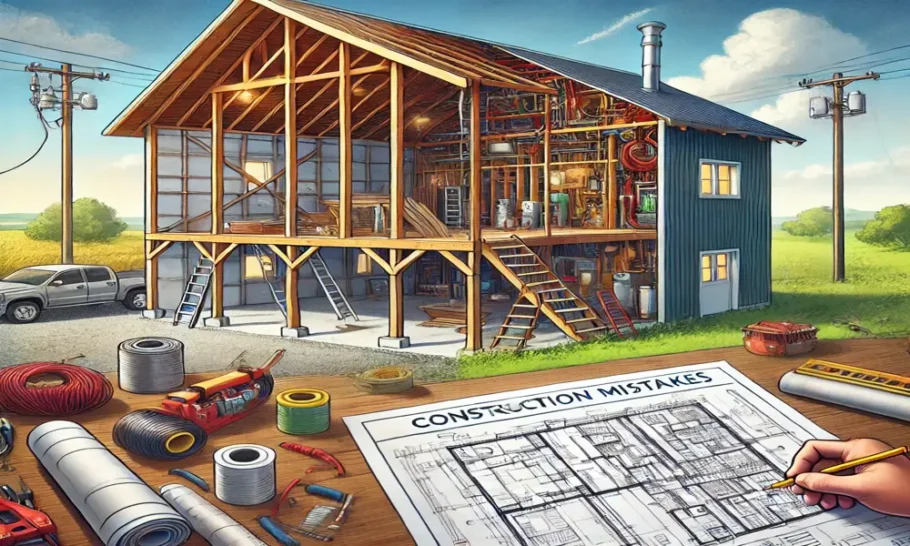When planning a barndominium — whether it’s a cozy 1,200-square-foot retreat or a sprawling family estate — one factor often underestimated is how crucial wind and snow load calculations are to the building’s integrity and safety. These elements are not just bureaucratic checkboxes for getting permits; they are vital engineering considerations that ensure your barndominium can withstand the forces of nature specific to your region.
In this article, we’ll dive into:
- What wind and snow loads are
- How they are calculated
- Why they vary across different regions
- How these loads directly influence structural design decisions
- And what you need to know before starting your project
Understanding Wind Load and Snow Load
Wind load refers to the pressure exerted by the wind on a structure. Snow load is the weight that accumulated snow exerts on a roof or other horizontal surfaces.
Both loads are measured in pounds per square foot (psf) and must be factored into the design to prevent structural failures such as collapse, sway, or progressive deterioration over time.
Engineers must calculate both loads meticulously to comply with national standards, such as:
- ASCE 7 (Minimum Design Loads and Associated Criteria for Buildings and Other Structures) — a primary reference
- IBC (International Building Code) — adopted by most municipalities
- Local codes that sometimes override national ones based on unique environmental conditions
How Geographic Location Affects Load Calculations
The geographic location of your barndominium dramatically influences both wind and snow loads. Here’s why:
- Wind Zones
Different parts of the U.S. and other countries are categorized into wind zones, largely based on historical storm data.
- Coastal regions like Florida, Louisiana, and the Carolinas experience hurricane-force winds. Structures here must be designed to resist winds upwards of 140–180 mph.
- Central U.S., often called “Tornado Alley” (Texas, Oklahoma, Kansas, Nebraska), faces high straight-line wind speeds and occasional tornado events.
- Mountainous areas also experience high wind speeds due to wind funneling through valleys and passes.
Example:
A barndominium in Key West, Florida, might need hurricane clips, reinforced concrete pilings, and impact-resistant windows. In contrast, a similar structure in Montana may focus more on heavy snow but less extreme wind uplift.
- Snow Load Zones
Snow loads vary significantly depending on latitude, altitude, and local weather patterns.
- Northern states (e.g., Minnesota, Maine, New York) experience heavy snowfall, sometimes requiring roofs to support snow loads upwards of 60–100 psf or more.
- Rocky Mountain areas can experience even heavier snow loads because of orographic lifting (where moist air is forced upward by mountains).
- Southern states like Texas or Georgia may only require minimal snow load considerations — if any.
Example:
A barndominium in Buffalo, New York must be designed for deep, heavy snow accumulation on flat and low-pitch roofs, which could exert tremendous downward force. Meanwhile, a project in Phoenix, Arizona, might virtually ignore snow loading altogether but focus on resisting occasional strong winds.
Key Factors in Load Calculations
When engineers calculate wind and snow loads, they consider a range of variables beyond just geographic location:
Wind Load Factors
- Basic Wind Speed: Based on location-specific maps (e.g., ASCE 7-22).
- Exposure Category: Open terrain, urban settings, wooded areas — each impacts wind behavior.
- Topography: Hills, cliffs, valleys can amplify wind forces.
- Building Height and Shape: Taller and oddly shaped structures catch more wind.
- Importance Factor: Buildings like hospitals have stricter standards than private homes.
Snow Load Factors
- Ground Snow Load (Pg): Basic value taken from maps and adjusted for elevation.
- Roof Slope: Steeper roofs shed snow easier, reducing load.
- Thermal Effects: Heated buildings melt snow differently than unheated ones.
- Drift Loads: Snow can pile up unevenly due to wind-driven drifts, especially around roof changes or mechanical units.
- Ice Loads: In some northern regions, ice accretion is an additional design consideration.
How These Calculations Impact Your Barndominium Design
Every pound of expected load affects:
- Material Choices: Thicker steel, higher-grade wood, stronger fasteners.
- Structural Systems: Bracing, moment frames, shear walls.
- Roof Design: Slope angles, truss spacing, purlin size.
- Foundation Requirements: Heavier loads demand deeper or broader footings.
- Insurance Costs: Structures built to better resist local conditions often earn lower premiums.
Ignoring or underestimating wind and snow loads can lead to disastrous consequences — structural failures, litigation, or invalidated insurance policies.
Real-World Examples
Florida Panhandle — Wind Focus
In 2018, Hurricane Michael flattened hundreds of poorly designed metal structures. Barndominiums built to withstand 170+ mph winds survived largely intact, demonstrating the life-saving impact of correct load calculation and resilient engineering.
Colorado Rockies — Snow Load Focus
Structures in Breckenridge, CO, are designed for snow loads over 100 psf. Engineers prioritize steep roof designs (sometimes up to 12:12 pitch) to shed snow and use heavy timber or steel frames that won’t buckle under the weight.
Midwest Tornado Zones — Mixed Threats
Barndominiums in Oklahoma often incorporate underground shelters and reinforced safe rooms, showing how multi-hazard considerations (wind, debris impact, minor snow) influence total design.
Tips for Barndominium Builders
- Hire a Licensed Structural Engineer: Never rely on stock barndominium plans without proper load adaptations.
- Get a Site-Specific Load Analysis: Your exact lot (even within a town) might have different conditions than a nearby area.
- Consult Local Codes Early: Building departments often require sealed plans showing compliance with wind and snow loads.
- Budget for Reinforcement: Don’t cut corners on structure. Skimping on loads can cost far more in the long run.
- Plan Rooflines Wisely: Consider snow drift zones when adding features like dormers, chimneys, and step-down roofs.
- Understand Elevation Changes: If you’re on a hilltop, expect higher wind pressure. If you’re in a valley, expect drifted snow piling against your building.
Conclusion
Designing a barndominium isn’t just about aesthetics, interiors, or even general floor plan flow — it’s about respecting the forces of nature unique to your location. Wind and snow load calculations form the backbone of safe, efficient, and code-compliant structures.
By understanding how geographic location shapes engineering decisions, you can make smarter choices, avoid costly mistakes, and ensure your dream barndominium stands strong for decades.
If you’re planning a barndominium project, start early by consulting professionals who understand your area’s specific needs. It’s not just about building a house — it’s about building a resilient, lasting home.

